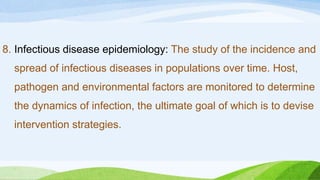EPIDEMIOLOGY PPT.pptx
- 1. EPIDEMIOLOGY
- 2. OVER VIEW âĒ What is Epidemiology âĒ Aims and Uses of epidemiology âĒ SCOPE- Areas and Fields of Epidemiology. âĒ Epidemiological Approaches âĒ Methods of Epidemiology. âĒ Concept of causation of Disease and Screening.
- 3. INTRODUCTION âĒ The term Epidemiology is derived from the Greek word Epidemic â âEpi means Among, uponâ âDemos means study of population or peopleâ and âLogos means scientific studyâ. âĒ The origin of epidemiology had been from the time of Hippocrates. But the foundation of modern epidemiology was laid down in the 19th century when infectious and communicable disease was most prevalent in the world.
- 4. ContdâĶ. âĒ It is the scientific study of the disease pattern in human population. In broad sense, it is the study of effects of multiple factors on human health. âĒ Epidemiology focus on communicable as well as non- communicable diseases.
- 5. DEFINITION ï· According to Lilenfield (1980), âEpidemiology is the study of distribution of disease or physiological condition in human population and of the factors that influence this distributionâ. OR
- 6. DEFINITION ï· âThe study of the distribution and determinants of health related states or events in specified population and the application of the study to control of health problemsâ. (J.M. Last,1988) OR
- 7. DEFINITION ï· According to Maxcy, âEpidemiology is the field of medical science which is concerned with the relationship of various factors, conditions which determine the frequencies and distributions of an infectious process, a disease or a physiologic state in a human communityâ.
- 8. AIMS OF EPIDEMIOLOGY According to International Epidemiological Association (IEA): ï· To describe the distribution and magnitude of health and disease problems in human population. ï· To identify etiological factors in the pathogenesis of disease.
- 9. ContdâĶ.. âĒ To determine the characteristics of the agent or causative factors. âĒ To provide the data essential to the planning, implementation and evaluation of service for the prevention, control and treatment of disease and to the setting up of priorities among those services.
- 10. USES OF EPIDEMIOLOGY âĒ Investigation of causation of disease. Genetic Factors Good Health ill Health Environmental factors
- 11. USES OF EPIDEMIOLOGY âĒ Study of the natural history and prognosis of diseases. âĒ Description of the health status of the populations. âĒ Evaluation of the interventions âĒ Planning health services, public policy and programs.
- 12. SCOPE OF EPIDEMIOLOGY MAJOR AREAS OF EPIDEMIOLOGY: 2. Disease Occurrence. 1. Disease Definition 3. Disease Causation 6. Disease Prevention. 4. Disease Outcome 5. Disease Management.
- 13. ContdâĶ. âĒ Disease Definition: - Characteristics or combination of character that best discriminate disease from non- diseased. âĒ Disease Occurrence: - The rate of development of new case in population. The proportion of current disease within population.
- 14. ContdâĶ.. âĒ Disease Causation: - The risk factors for disease development and their relative strength with respect to an individual and population. âĒ Disease Outcome: - The outcome following disease onset and of the risk factor.
- 15. ContdâĶ.. âĒ Disease Management: - The relative effectiveness of proposed therapeutic interventions. âĒ Disease Prevention: - The relative effectiveness of proposed preventive strategies including screening.
- 16. VARIOUS FIELD OF EPIDEMIOLOGY: - 1. Aging epidemiology: Examines the public health impact of aging societies, and the multifactorial changes associated with aging that make health issues for older persons important and unique. 2. Applied public health epidemiology: Areas of focus include population health status assessment; infectious and chronic
- 17. contdâĶ disease surveillance and control; maternal and child health epidemiology; and environmental health epidemiology. 3. Cancer Epidemiology: Cancer epidemiology is the study of the distribution and determinants of the likelihood of cancer development.
- 18. ContdâĶ. 4.Cardiovascular and diabetes epidemiology: It is the study of the distribution and determinants of the likelihood of cardiovascular disease and diabetes development. 5. Clinical trials and methods: The activities of the epidemiologic methods group contribute to all areas of emphasis, specializing in design and conduct of studies including adaptive trials,
- 19. ContdâĶ. survey sampling, and statistical methods. 6. Environmental epidemiology: Environmental epidemiology is a branch of epidemiology concerned with determining how environmental exposures impact human health. This field seeks to understand how various external risk factors may predispose to or protect against diseases, injury or death.
- 20. 7. Global health epidemiology: Global health epidemiology addresses the causes and consequences of morbidity and mortality that cross-regional or national boundaries, with emphasis on research in resource-poor countries and application of research findings to the implementation of programs to promote health in those areas.
- 21. 8. Infectious disease epidemiology: The study of the incidence and spread of infectious diseases in populations over time. Host, pathogen and environmental factors are monitored to determine the dynamics of infection, the ultimate goal of which is to devise intervention strategies.
- 22. 9. Injury prevention epidemiology: Emphasis on the application of epidemiologic methods in population and clinical settings to understand key risk and prognostic factors for primary and secondary prevention of injury. 10. Forensic epidemiology: The discipline of forensic epidemiology, a branch of forensic medicine, provides a systematic approach
- 23. ContdâĶ. to the assessment of general and specific (individual) causation, with the results suitable for presentation in a court of law. 11.Molecular and genetic epidemiology: Molecular epidemiology is a branch of epidemiology and medical science that focuses on the contribution of potential genetic and environmental risk factors, identified at the molecular level, to the aetiology,
- 24. distribution, and prevention of disease within families and across populations. 12. Population neuroscience: Focuses on the application of epidemiology methods and cutting-edge neuroimaging methodologies in population and clinical studies to enhance etiological research and evaluation of specific therapies in the disorders of the central nervous system.
- 25. 13. Occupational epidemiology: Occupational epidemiology is a sub discipline of epidemiology that focuses on investigations of workers and the workplace. 14. Reproductive, perinatal, and paediatric epidemiology: This area focuses on the determinants of health and disease in reproduction and childhood development.
- 26. ContdâĶ. 15.Prevention, lifestyle, and physical activity epidemiology. 16.Womenâs health epidemiology: Womenâs health epidemiologists conduct research to improve the physical and mental health, safety and well-being of the maternal and child health.
- 27. ContdâĶ. 17.Psychiatric epidemiology: The psychiatric epidemiology area of emphasis focuses on the acquisition of epidemiological, bio statistical, and psychiatric concepts and methods, and on their application to research in the field of psychiatric disorders. 18.Obesity and nutritional epidemiology: The study of nutrition and other behavioral factors and their relation with population health.
- 28. TERMINOLOGIES USED IN EPIDEMIOLOGY âĒ INFECTION: The entry and development or multiplication of an infectious agent in the body of man or animal. âĒ INFESTATION: Infested article are those which harbor or gives shelter to animal forms, especially arthropods and rodents.
- 29. TERMINOLOGIES USED IN EPIDEMIOLOGY âĒ EPIDEMIC: A widespread occurrence of an infectious disease in a community at a particular time. âĒ ENDEMIC: It refers to the constant presence of a disease or infectious agent within a given geographical area or population group, without importation from outside. For example, common cold is endemic.
- 30. TERMINOLOGIES USED IN EPIDEMIOLOGY âĒ SPORADIC: It occurring at irregular intervals, only in a few place scattered or isolated..eg.. Polio, Herpes etc. âĒ PANDEMIC: An epidemic usually affecting a large proportion of the population occurring over a wide geographic area such as a section of nation. Eg. Influenza pandemics of 1918 and 1957.
- 31. THANK YOU






























